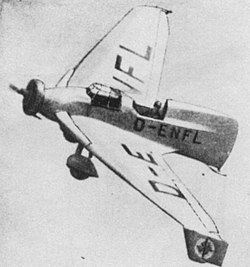DFS 39
| DFS 39 | |
|---|---|
 DFS 39 |
|
| Type: | Experimental airplane |
| Design country: | |
| Manufacturer: | |
| Number of pieces: |
1 |
The DFS 39 Delta IVc was a tailless test aircraft from the German Research Institute for Glider Flight (DFS).
development
The aircraft was developed in 1935 as a test aircraft of the Delta series based on the Fieseler F 3 . The aim of this series of tests, designed by Lippisch, was to examine tailless aircraft, i.e. aircraft without a horizontal stabilizer, for their flight stability. The Delta IVc was created as a result of previous samples and at the suggestion of Lippisch. It should be demonstrated that the stability around the vertical axis can be achieved by downwardly angled wing tips together with keeled surface extensions. With the Delta IVc this theory could be proven to be correct.
construction
The aircraft was designed as a tailless, self-supporting low- wing aircraft made of wood. The trunk was formed into a cutting edge that stood perpendicular to the rear. In addition, a fixed normal chassis and an air-cooled Pobjoy radial engine with 85 hp were used. The two-man crew sat one behind the other in separate seats.
Technical specifications
| Parameter | Data DFS 39 d - Delta IVc |
|---|---|
| crew | 1 |
| Passengers | 1 |
| length | 5.4 m |
| span | 9.6 m |
| height | 1.8 m |
| Wing area | 13.4 m² |
| Wing extension | |
| Empty mass | 390 kg |
| Max. Takeoff mass | 600 kg |
| Cruising speed | |
| Top speed | 220 km / h |
| Service ceiling | 6300 m |
| Range | 1350 km |
| Engines | a Pobjoy radial engine ; 85 hp (63 kW) |
literature
- Alexander M. Lippisch : Tailless Tailpiece . In: AIR Enthusiast September 1972, pp. 136-138, 150


